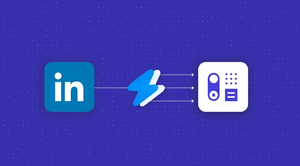Marketing often takes a back seat when you're busy running a business. You're focused on serving customers, covering costs, and keeping things moving. Spending money on promotion can feel out of reach.
But if people don’t know about you, they won’t get in touch. Being visible still matters — even when money’s tight.
This guide shares simple ways to promote your business without adding to your expenses. They're easy to pick up when time and tools are limited.
Before the marketing planning starts…
Before you post anything, send an email, or set up an ad, get clear on two things:
Who you want to reach and why they’d choose you over someone else.
This doesn’t have to be complicated, but it does matter. Even free tools take time, and your effort will go further if it’s focused.
Here’s how to get started:
- Look at your best customers. Who comes back, who sends others your way? That group is often your real audience, not just who you hoped to reach, but who’s already choosing you.
- Ask yourself why people pick you. Is it your prices? Your speed? The way you handle service? That’s your edge, and your reason to stand out.
- Get specific. “Local shop owners looking for better IT support” is clearer than “anyone who needs help with tech.” The more focused you are, the more your message will click.
- Listen closely. Read your reviews. Ask regulars what they’d tell a friend about your business. Their words are more powerful than your guesses.
- Write it down. Just a few sentences are enough. Who are you for? What makes you different? That small summary will help guide every marketing move you make.
Top small business marketing ideas to try
Once you know who you’re trying to reach and why they’d choose you, it’s time to get the word out.
1. Social media without spending a penny
Social media works! Especially when it’s consistent, useful, and aimed at the right audience. You don’t need a full content strategy to stay top of mind.
Start with one platform your customers already use:
- Facebook or Instagram for local services, hospitality, or retail
- LinkedIn for B2B and professional services
- TikTok for hands-on or visual businesses
Keep posts simple and focused. Show something helpful. Give a behind-the-scenes look. Share something recent you’re proud of.
A great example:
Restore & More Bristol shared a short decluttering tip with a visual checklist. It’s quick, useful, and sounds like something they’d actually say to a client.
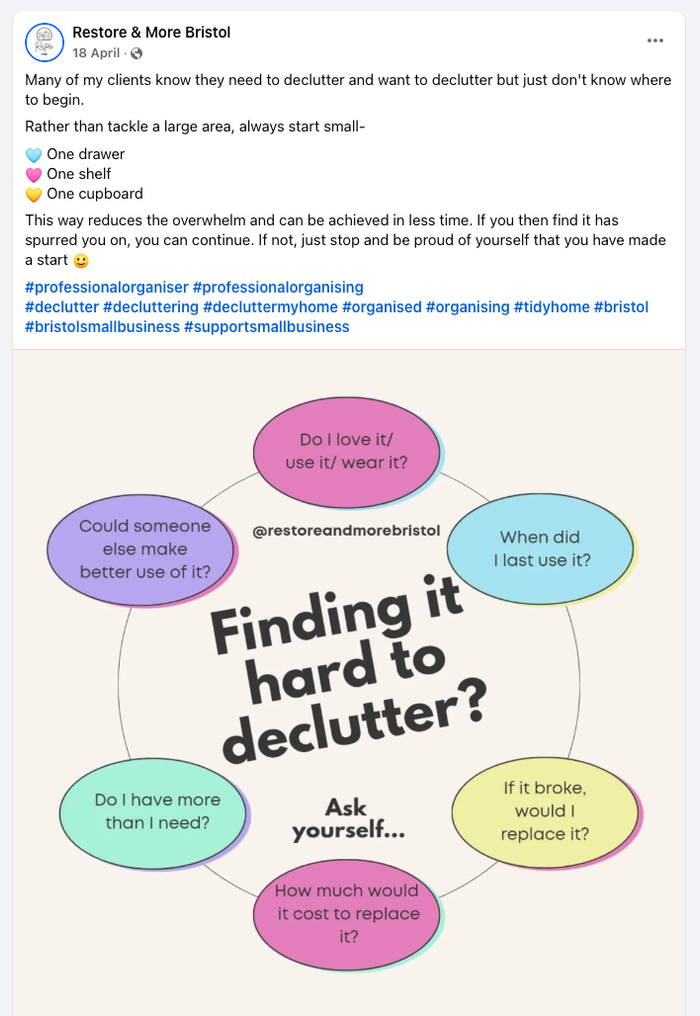
Short videos tend to perform best. 73% of consumers prefer short-form videos when researching products or services. A 10-second clip of a new product, a sped-up behind-the-scenes task, or a tip in action can earn more attention than a static post.
If a post gains traction, consider boosting it. A small ad budget — even £10 — can get it in front of hundreds of potential customers. Target by location or job title to stay relevant.
Helpful resources:
- Facebook Ads Manager: tips on getting started and more
- LinkedIn Marketing Labs: free training for advertising on LinkedIn
- TikTok: Small Business Resource Center
- Social media marketing for small businesses: a handy guide
2. Create content that brings in leads
Your customers are already searching for answers. A tool like KeywordsPeopleUse shows you the exact questions people type into Google, grouped by topic.

Let’s say you run a small coffee roastery. You plug in “coffee roasting” and see questions like:
- “What’s the 15-15-15 coffee rule?”
- “How to roast coffee at home?”
- “What are the four types of coffee roasts?”

Those are ready-made content ideas. Write a short guide, film a one-minute explainer, or create a visual cheat sheet answering just one of them. It helps people and increases your chances of showing up in search results – and in LLMs.
Content marketing pulls more than its weight. On average, it generates three times as many leads as traditional advertising and costs 62% less. And it keeps paying off long after you hit publish. One blog post can become a LinkedIn post, a how-to email, or even a short video script. One idea, many uses — and no extra spend.
Helpful resources:
- Content marketing for small business owners: a practical guide
- The ultimate guide to creating a content marketing plan
3. Show up on Google when people need you most
When someone searches “best café near me” or “plumber in Leeds,” they’re not browsing casually: they’re ready to take action. That’s why appearing in local Google results matters more than ever.
Take a quick search for “personal injury lawyer Seattle.”
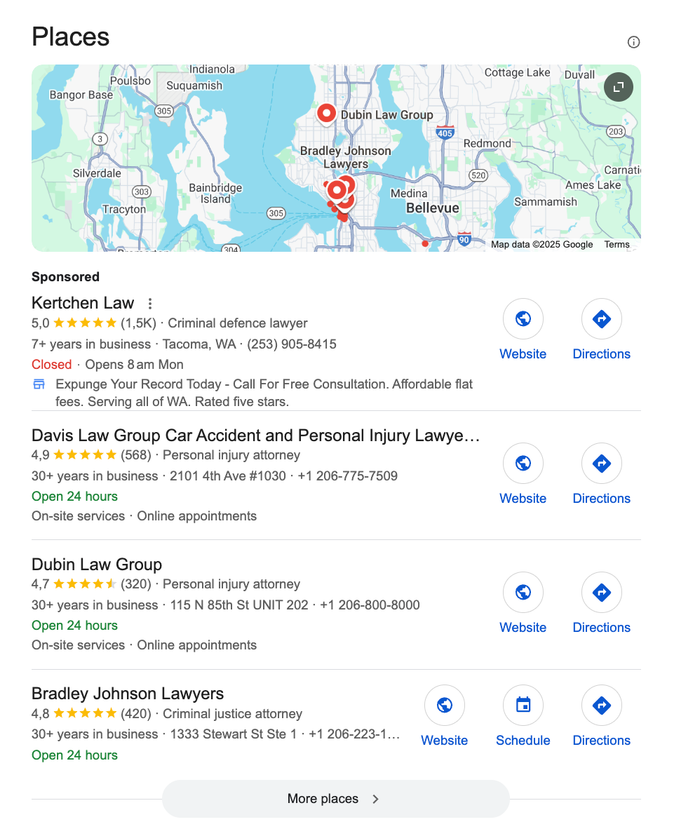
You’ll see listings with photos, reviews, service breakdowns, even mentions on networks like CNN and CBS.

That visibility doesn’t come from ads; it comes from having a solid local SEO setup and a complete Google Business Profile.
This applies to any business. Whether you’re a café, accountant, florist, or freelance coach, being discoverable through search drives action.
Here’s how to get started:
Claim your Google Business Profile. Head to google.com/business, verify your listing, and add the essentials: address, phone number, opening hours, website, and a few clear photos.
Ask for reviews. Happy customers are usually glad to help, you just have to ask. A single review can tip the balance for someone comparing you to a competitor.
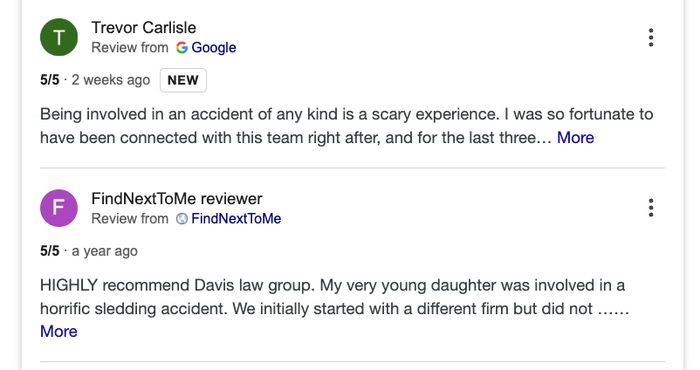
Add local cues to your website. Include your town or region in page titles, meta descriptions, and headers. For example: “Family-run bakery in Sheffield” or “Bookkeeping services for Kent businesses.”
Answer real search questions. Use your site or blog to answer the kind of questions people search for – for example, “Do I need an accountant if I’m self-employed?”
This kind of content helps you build credibility with future customers.
Helpful resources:
- Webinar: how to implement SEO in your business
- The best SEO tools for small businesses
- Local SEO checklist
4. Stay in touch and top of mind with email marketing campaigns
Email marketing can look like a lot: templates, GDPR compliance, tools, segmentation. But if you want to dip your toes in, you don’t have to build a full campaign from day one.
However, if you don’t already have customer consent, a privacy policy, or a tool to manage emails properly, this might not be your first move. Stick to social or local visibility for now.
But if you do have some emails from recent customers, and a clear way to show they opted in, start small. One plain-text email can go a long way. You can:
- Share a quick update (“We’ve moved,” “New opening hours”)
- Add a useful tip (“Here’s how to prep your boiler for winter”)
- Or give a reason to return (“10% off for repeat customers this month”)
Use a tool like Transpond or Mailchimp: they handle the hard stuff like unsubscribes and tracking. Just make sure your list is clean and permission-based.
Want to send better emails? Here’s a real example that works
Email marketing doesn’t have to be complicated to be effective. Take this one from Wuffes, a dog supplement brand — it’s a great example of a small business doing email right.
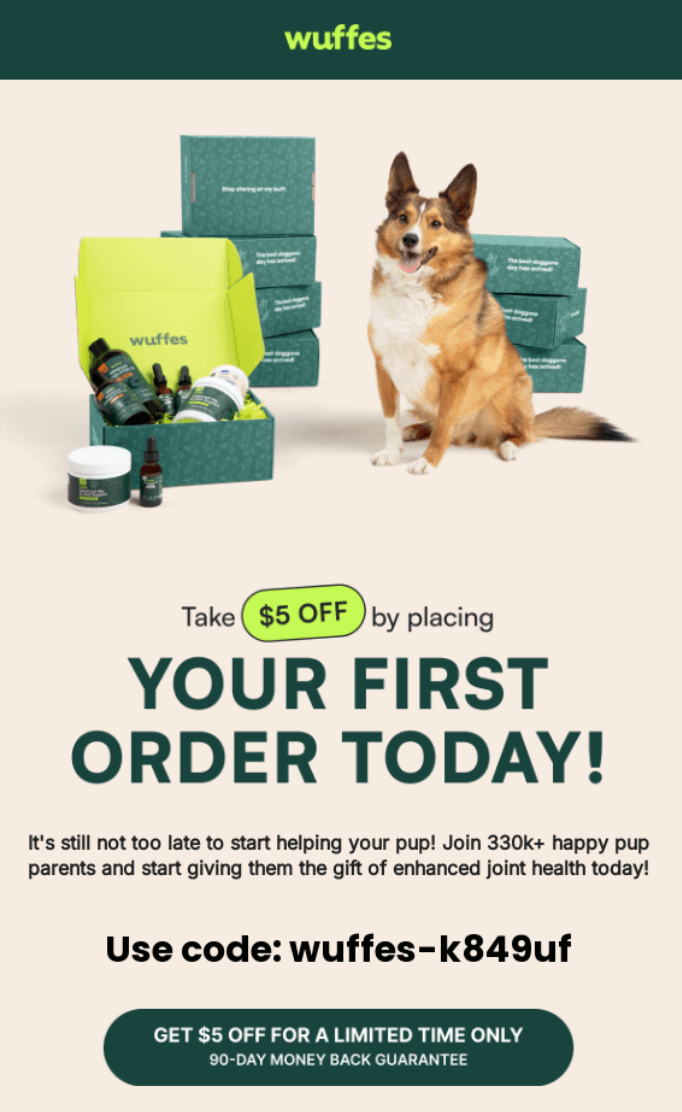
Subject: Clear offer
“Take $5 OFF by placing your first order today” — full of value.
Visual: One strong image
The dog is front and center, surrounded by the product. It’s warm, friendly, and instantly communicates what’s being sold.
Copy: Short and benefit-focused
“It’s not too late to start helping your pup!” — direct and empathetic, followed by a simple social proof stat: “Join 330k+ happy pup parents…”
CTA: Repeated and prominent
- “Use code: wuffes–k849uf”
- A button that reinforces urgency: “Get $5 off for a limited time only”
Guarantee: Added reassurance
“90-day money back guarantee” quietly builds trust without taking up space.
Why does this work?
It’s one offer, one message, one ask. For a small business, that simplicity is your superpower.
If you’re just getting started with email, follow this structure:
- One clear offer or update
- One image (your product, your team, your space)
- One next step (“Reply,” “Book,” “Click”)
You can always layer in more later. But for now? Keep it light and helpful.
Helpful resources:
- Should you use email marketing for your small business?
- Best free and cheap email marketing tools for small businesses
- Transpond or Mailchimp: which marketing platform should you use with Capsule CRM?
- 11 email marketing ideas you should try
5. Turn your happy customers into your best marketers
Word of mouth has always been powerful, but today it shows up in more places: Google reviews, Facebook comments, WhatsApp groups, even screenshots in DMs. If someone says something good about your business, you want future customers to see it.
You don’t need to sit back and hope it happens. You can guide it.
Why it matters:
- People trust reviews. Customers trust reviews from other customers as much as personal recommendations.
- It’s free. No ad budget needed, just a bit of timing and consistency.
- It multiplies. One strong review can influence dozens of new customers.
Make it easy to give feedback
The easier it is to leave a review, the more likely people are to do it. Take a cue from Birmingham Airport: their “rate your experience” email uses five simple stars.

You can do the same with a quick email or SMS. Include a star rating or a direct link to your review platform (Google, Trustpilot, Facebook).
Personalize the ask
Look at how The Body Shop handles it — when someone makes a purchase, they follow up with a review request that’s:
- Polite and direct
- Linked to the exact item they bought
- Reinforced by other product links to keep them engaged
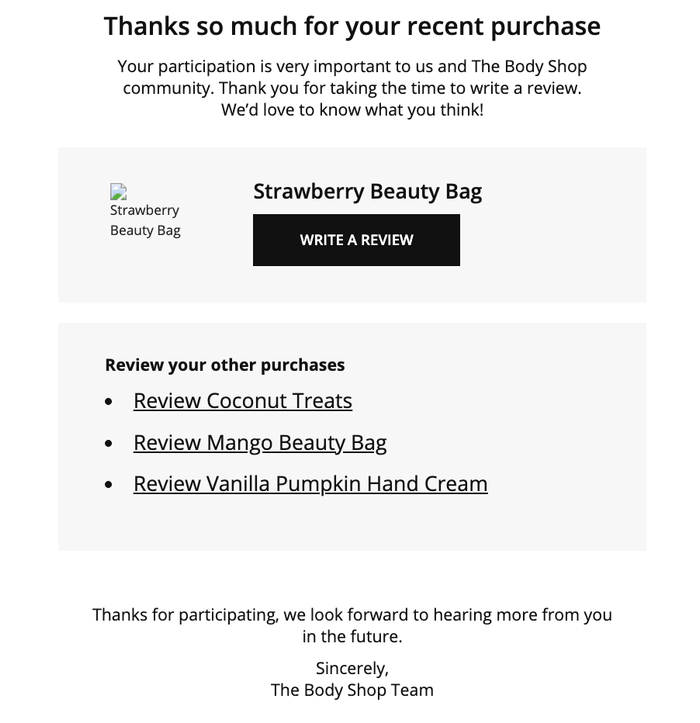
Even small businesses can do this. After a job or delivery, send a friendly message:
“Thanks so much for your order, [Name]! If you had a good experience, would you mind leaving us a quick review here? It really helps.”
Show your reviews in the wild
Trustpilot reviews (like the five-tiered graphic you might’ve seen) don’t just live on the review site. Businesses embed them on their websites, include them in newsletters, or repurpose quotes for social media.

Don’t forget referrals
Reviews help strangers trust you. Referrals bring in their friends. A small gesture — 10% off or even a personal thank-you — can nudge your happiest customers to become advocates.
6. Join communities
When budgets are tight, one of the first things small business owners search for is “free ways to market my business.” This is one of them.
It doesn’t cost money — just a bit of time and consistency.
All you need to do is join the online spaces where your potential customers already go to ask questions and swap advice.
Think:
- Facebook Groups for your town or trade
- LinkedIn Groups for your industry
- Local forums like Nextdoor or community WhatsApp chats
- Q&A sites like Reddit or Quora
People ask for help all the time:
“Can anyone recommend a decent bookkeeper for a small business?” “We’re planning a school trip — know any good travel agents?”
If you’re there, and you offer a useful answer (not a sales pitch), you’ll get noticed — and remembered.
How to get started:
- Search smart. Use the kind of phrases your customers would — “IT help for cafés in Leeds” or “eco cleaners in Brighton.”
- Lurk first. Get a feel for the tone and see what people talk about. Respect any group rules.
- Be helpful. Answer a question. Share a tip. Link to something genuinely useful (like a checklist or blog you’ve written).
- Mention your business only when it makes sense. A simple line like “I run a local design studio if you need help” is enough.
Real example: giving help = building visibility
In one Facebook group, a small plumbing business owner posted a screenshot of their first Google Ads campaign. They were stuck — their ad wasn’t showing, and they didn’t know why.
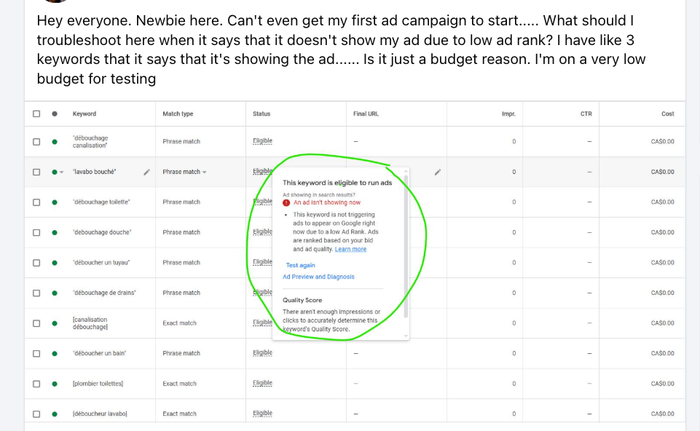
Within hours, people jumped in with tips: raise your bids slightly, check your quality score, try fewer keywords to start. One person even shared a free diagnostic tool.
And that’s how you build visibility among your future clients.
7. Try guerrilla marketing
If your ad budget is basically “whatever’s in the till this week,” guerrilla marketing might be your best friend.
Guerrilla marketing is all about creativity over cash. Instead of big ad campaigns, you use low-cost, unexpected tactics to grab attention, right where people live, walk, or scroll.
Done well, it can:
- Get people talking (and posting) for free
- Build local awareness fast
- Show your brand’s personality, not just your product
A few real examples that worked:
Heyday Canning Co. set up a “bean swap”: bring any old can from home and trade it for one of theirs.

Dollar Shave Club didn’t use stunts. In 2012, they launched a simple, no-frills video featuring their founder walking through a warehouse:
The video went viral, clocking over 12,000 orders in the first 48 hours and eventually helping them scale into a $1 billion brand.
Do something small and smart that people can’t help but notice — and maybe share.
Big results don’t always need a big budget
You might not have a marketing team or deep pockets, but you’d be surprised how far creativity and consistency can take you. It all adds up.
Choose a few tactics you can realistically commit to – then do them well. You don’t need to be everywhere. Just be clear, be useful, and be findable where your customers are already looking.
Good luck!




